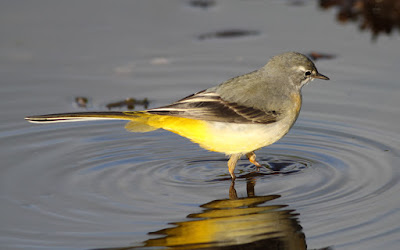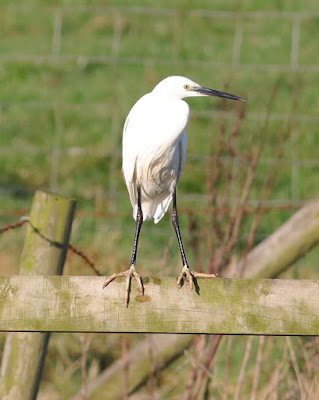Friday. After clearing frost from the screen I set off into bright sunshine. Things rapidly went downhill.
I found a nice selection along Lancaster Road – 2 Buzzards, a Kestrel and about 40 Fieldfares in their usual field. The farmer recently cleared his midden and left some puddles, still unfrozen in the shelter of the hedgerow. Here were a dozen Chaffinch, a Grey Wagtail, a Pied Wagtail, a couple of Meadow Pipit, and then a pair of Mistle Thrush rattling off at my arrival.
At Gulf Lane the Linnets numbered 250+ and there was another Buzzard circling behind the farm where 4 Stock Doves eyed up the barn. There was little to see at Braides Farm where the frosty flood had deterred the usual melee of waders and wildfowl. I made do with a Kestrel and a mixed flock of several hundred Golden Plover and Lapwing partly hidden in the distant and undulating pastures.
At Conder Pool I caught up with the Great White Egret, perhaps the one I saw some months ago leaving the mainly Little Egret roost at Pilling But since then there have been multiple sightings of more than one Great Egret, the next candidate to become a more common occurrence in our area.
Also on the pool - 3 Little Grebe, 40 Wigeon, 2 Goosander, and 5 Black-tailed Godwits “over”.
Black-tailed Godwits
On the incoming tide the Spotted Redshank flew over the water, east to west. Across to the distant bridge I could see the wintering Common Sandpiper bobbing along the water’s edge where the count of Teal here and on the pool surpassed 150 again. The light was failing with patchy mist on the way and by now I was on ISO1200.
At Pilling I happened upon some geese where amongst a couple of hundred Pink-footed Geese were ten “Russian” White-fronted Geese and the single Red-breasted Goose.
The latter, almost certainly a feral/escape bird has been a major target bird of recent weeks to the car loads of bird watchers heading into the Fylde.
But the first mentioned are the truly wild geese, here to spend time many miles from the freezing Russian winter.
Russsian White-fronted Geese and Red-breasted Goose
Thirty years ago White-fronted Geese, both “Russian and “Greenland” used to be more common amongst our huge wintering flocks of Pink-footed Geese but nowadays both races of white-front are very scarce. So uncommon are they that they have become a target for recent convert birders who may have never seen the species. Likewise the white-fronts are a “must see” for those bird watchers who maintain a year-list in keeping up with the Joneses.
As the name suggests the white-fronts originate from western Russia where the breeding population numbers some 200,000 adults. The adults together with their young of the year, in total up to about 600,000 birds, spend the winter in some numbers in the Low Countries of Europe. There are up to 300,000 in Holland alone. In recent years the Dutch afforded extra protection to the similarly wintering but seriously endangered Lesser White-fronted Goose by way of safe roosting areas and tighter regulation of shooting. This policy also helps the White-fronted Goose and probably accounts for the reduction of numbers seen in the UK and here locally in Lancashire as the white-fronts now have less reason to leave Holland and fly the North Sea to the UK.
Meanwhile the Red-breasted Goose breeds in Arctic Siberia, mainly on the Taymyr Peninsula with a summer population of around 80,000 adults, much further east than the Russian White-fronted Goose. There has been a strong decline in numbers of Red-breasted Goose in recent decades but most winter along the north-western shores of the Black Sea in Bulgaria, Romania and Ukraine (occasionally moving further southwest to Greece). Some birds may now winter farther west as indicated by recorded counts of 2,000 birds in Hungary as in the winter of 2014, whereas counts previously only accounted for a few hundred. Given the worsening outlook for the species as a whole, the Red-breasted Goose was lifted from a species of Least Concern to that of Endangered status in 2007.
Our single Red-breasted Goose Branta ruficollis turned up at at Pilling a couple of weeks ago and seemed to arrive with a number of Russian White-fronted Geese, up to twenty of the latter.
The usual 'carrier species' for a genuinely wild Red-breasted Geese is the related and dark-bellied form of Brent Goose, Branta bernicla bernicla, another resident of high Arctic Russia which also winters in the area of the Baltic Sea coasts of Denmark and Holland.
Red-breasted Geese are common in captive wildfowl collections, most notably in the UK at Wildfowl Trust collections at Minsmere, Sussex and Martin Mere, Lancashire where the species has bred in recent years. Here they mix freely with captive, feral and wild geese that inhabit the many acres of managed wetland and where a feeding policy is employed.
As a very attractive and ornamental goose it is also popular with private collectors with a couple of hundred pounds spare with which to enhance their assortment of exotic waterfowl. Despite the purchase cost escapee Red-breasted Geese are fairly frequent given the amount of skill, time and experience required to prevent the geese from reverting to their natural inclinations to fly.
In Holland the Red-breasted Goose sells well.
"Out of devoted love for waterfowl, the founder Mr. P. Kooy established our breeding farm on a 12 acre area bordering the sand dunes in the most northern part of the province of Noord-Holland. A most ideal spot due to the freshwater supply of the dunes and the sea-climate.
Several first breedings were the result.
Among these first breedings we achieved, were the Eyton's Tree Duck, Hottentot Teals, Baer's Pochard and the Radjah Shelduck. Jean Delacour and Sir Peter Scott mention this achievement in 'Waterfowl of the World'.
Besides all species of swans we keep almost every species of geese on our farm.
Many pairs of Red-Breasted Geese lord over the many other species on our beautifully planted ponds. The Orinoco Goose, the Emperor Goose, the Hawaiian Goose and the Cape Barren Goose are always available as well as many others. We have on our farm about 150 different species of waterfowl and the stock fluctuates between 1500 and 3000 birds.”
Red-breasted Geese





















































.jpg)














